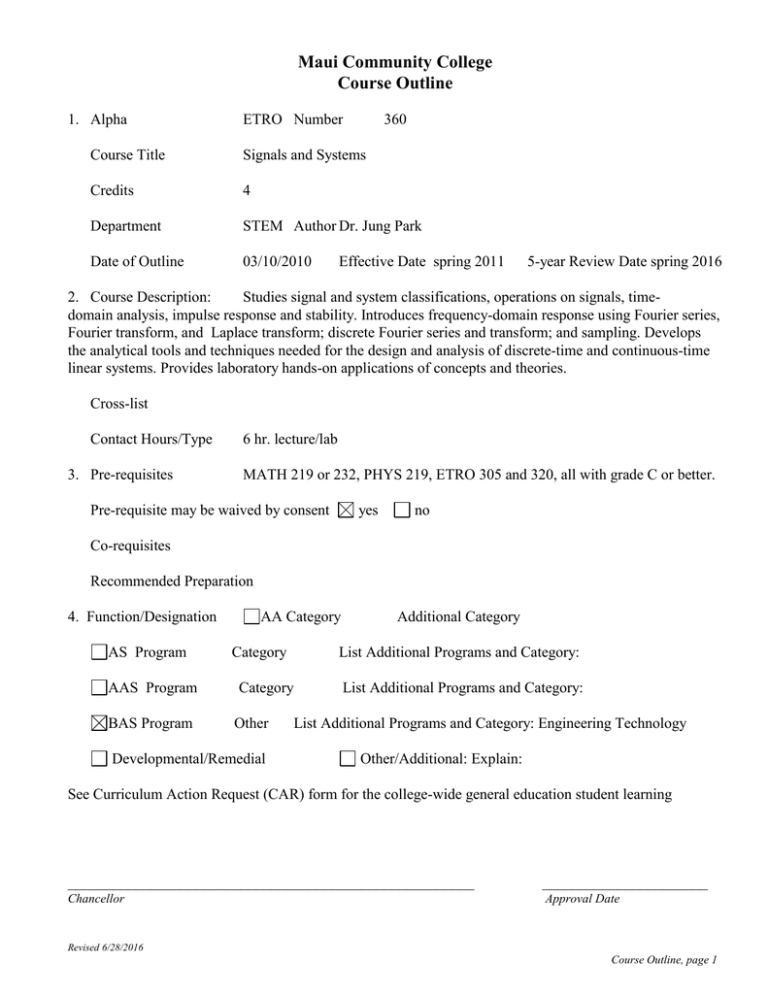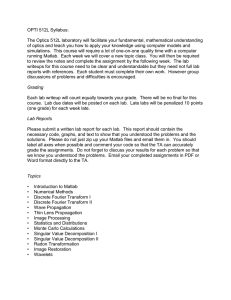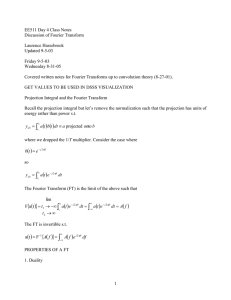2009.30 - Electronics (ETRO) 360: Signals and Systems, Course Outline
advertisement

Maui Community College Course Outline 1. Alpha ETRO Number 360 Course Title Signals and Systems Credits 4 Department STEM Author Dr. Jung Park Date of Outline 03/10/2010 Effective Date spring 2011 5-year Review Date spring 2016 2. Course Description: Studies signal and system classifications, operations on signals, timedomain analysis, impulse response and stability. Introduces frequency-domain response using Fourier series, Fourier transform, and Laplace transform; discrete Fourier series and transform; and sampling. Develops the analytical tools and techniques needed for the design and analysis of discrete-time and continuous-time linear systems. Provides laboratory hands-on applications of concepts and theories. Cross-list Contact Hours/Type 3. Pre-requisites 6 hr. lecture/lab MATH 219 or 232, PHYS 219, ETRO 305 and 320, all with grade C or better. Pre-requisite may be waived by consent yes no Co-requisites Recommended Preparation 4. Function/Designation AS Program AAS Program BAS Program AA Category Category List Additional Programs and Category: Category Other Developmental/Remedial Additional Category List Additional Programs and Category: List Additional Programs and Category: Engineering Technology Other/Additional: Explain: See Curriculum Action Request (CAR) form for the college-wide general education student learning ______________________________________________________ ______________________ Chancellor Approval Date Revised 6/28/2016 Course Outline, page 1 2 outcomes (SLOs) and/or the program learning outcomes (PLOs) this course supports. This course outline is standardized and/or the result of a community college or system-wide agreement. Responsible committee: 5. Student Learning Outcomes (SLOs): List one to four inclusive SLOs. For assessment, link these to #7 Recommended Course Content, and #9 Recommended Course Requirements & Evaluation. Use roman numerals (I., II., III.) to designate SLOs On successful completion of this course, students will be able to: I. Utilize basic concepts of signals, systems and transforms. II. Classify, analyse and design systems in both the time- and frequency-domains. III. Solve the problems related to analysis of signals and systems and compute the system output. IV. Use Matlab-based software to represent signals and systems and to compute the system output. 6. Competencies/Concepts/Issues/Skills For assessment, link these to #7 Recommended Course Content, and #9 Recommended Course Requirements & Evaluation. Use lower case letters (a., b.…zz. )to designate competencies/skills/issues On successful completion of this course, students will be able to: a. Identify and classify signals and systems. b. Represent the input-output relationship of a linear time-invariant continuous-time system (LTIC) by means of a differential equation. c. Find the zero-input, unit impulse, and zero sate response of a LTIC system. d. Determine the system response using the convolution integral. e. Evaluate the transfer function and stability of a LTIC system. f. Characterize periodic and aperiodic signals using the Fourier series and Fourier transform. g. Represent signals and systems using the Laplace transform. h. Determine the zeros, poles, and stability of a LTIC system. i. Create and analyze Bode plots. j. Utilize MATLAB programs to process signals and display results. 7. Suggested Course Content and Approximate Time Spent on Each Topic Linked to #5. Student Learning Outcomes and # 6 Competencies/Skills/Issues Introduction to MATLAB. 1-2 weeks (I, II, IV, a, j) Basic signal generation. 2-3 weeks (I, II, IV, a, b, c, j) Convolution. 2-3 weeks (I, II, III, IV, a, b, c, d, j) Fourier series. 2-3 weeks (I, II, III, IV, a, b, c, f, j) Modulation examples. 2-3 weeks (I, II, III, IV, a, b, e, j) Fourier transform. 2-3 weeks (I, II, III, IV, a, b, c, f, j) Laplace transform. 2-3 weeks ((I, II, III, IV, a, b, c, g, i, j) System function and frequency response. 2-3 weeks (I, II, III, IV, a, b, c, h, j) 8. Text and Materials, Reference Materials, and Auxiliary Materials Appropriate text(s) and materials will be chosen at the time the course is offered from those currently available in the field. Examples include: Revised 6/28/2016 course outline 3 E. Kamen, B. Heck, "Fundamentals of Signals and Systems Using the Web and MATLAB", 3/E, Prentice Hall, 2006, ISBN-10: 0131687379, ISBN-13: 978-0131687370 Appropriate reference materials will be chosen at the time the course is offered from those currently available in the field. Examples include: D. Hanselman and B. Littlefield, "Mastering Matlab 7", 1/E, Prentice-Hall, 2004, ISBN-10: 0131430181 ISBN-13: 978-0131430181 Appropriate auxiliary materials will be chosen at the time the course is offered from those currently available in the field. Examples include: Software such as MATLAB 9. Suggested Course Requirements and Evaluation Linked to #5. Student Learning Outcomes (SLOs) and #6 Competencies/Skills/Issues Specific course requirements are at the discretion of the instructor at the time the course is being offered. Suggested requirements might include, but are not limited to: Labs/exercises: 40-60% (I, II, III, IV, a-j) Class participation: 10% (I, II, III, IV, a-j) Projects/research: 10-20% (I, II, III, IV, a-j) Quizzes (In class & pre-class): 10-20% (I, II, III, IV, a-j) Written examinations: 10-30% (I, II, III, IV, a-j) 10. Methods of Instruction Instructional methods will vary considerably by instructor. Specific methods are at the discretion of the instructor teaching the course and might include, but are not limited to: Inquiry lab experiences. Lab activities and exercises. Demonstrations. Group projects or team challenges. Audio/visual presentations (pre-prepared or internet-based). Class discussions. Guest speakers or field trips. Lectures. 11. Assessment of Intended Student Learning Outcomes Standards Grid attached 12. Additional Information: Revised 6/28/2016 course outline






